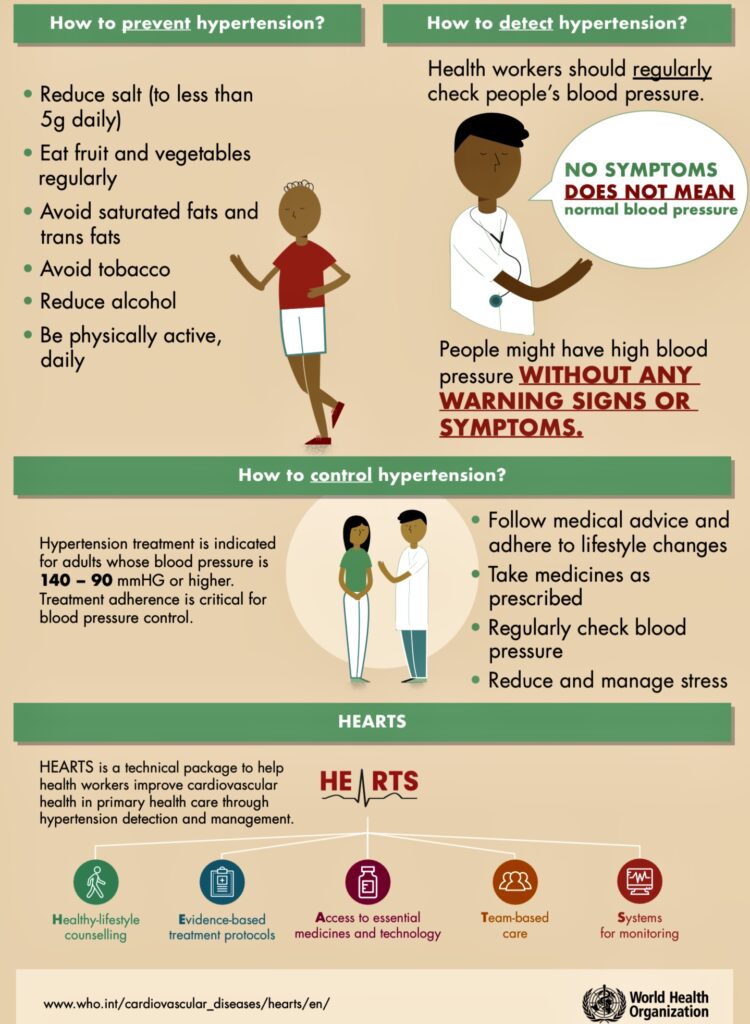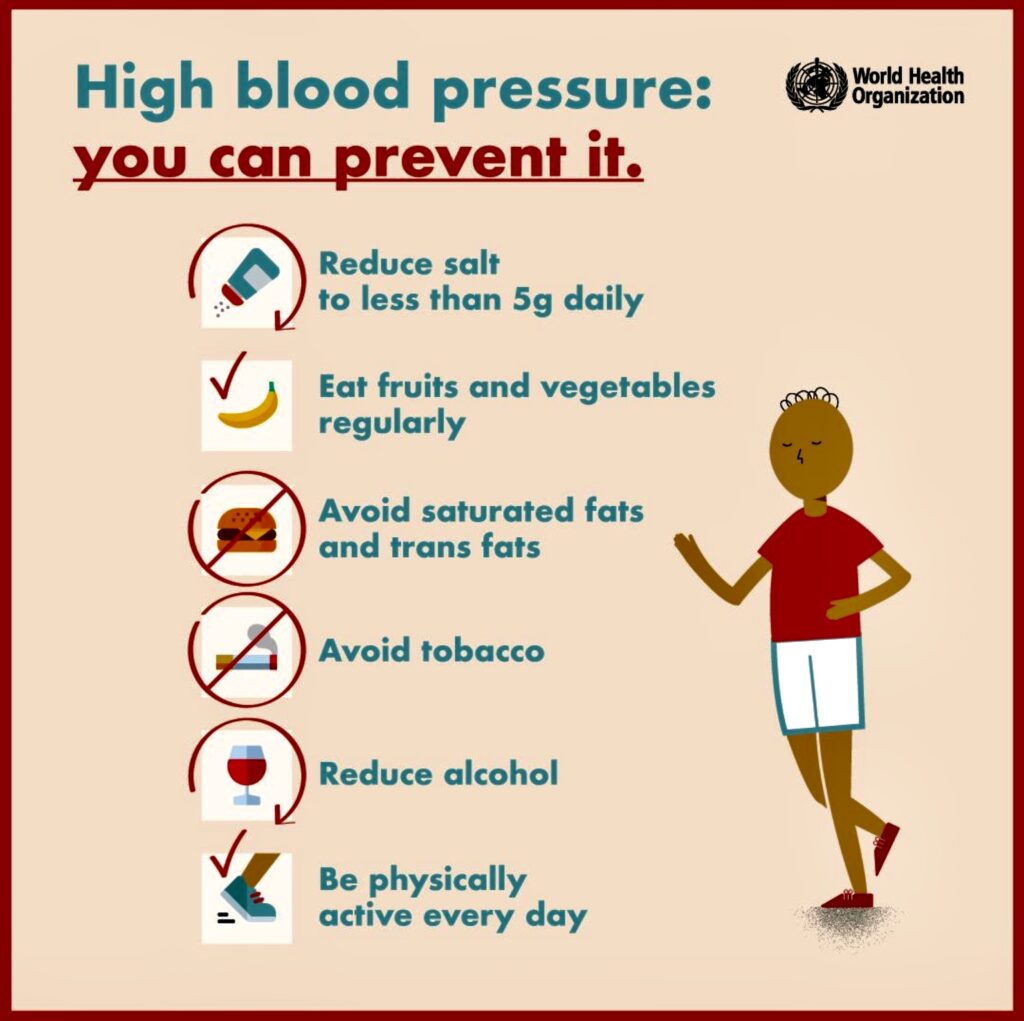HYPERTENSION: WHEN BLOOD PRESSURE GOES UP
By Henrylito D. Tacio
Photo courtesy of WHO
Everybody has – and needs – blood pressure. Without it, blood can’t circulate through the body, giving vital organs the oxygen and food they need.
Under normal conditions, our heart beats about 60 to 80 times a minute. Our blood pressure rises with each heartbeat and falls when our heart relaxes between beats. Like the air pressure in tires, our blood pressure can change from minute to minute.
The pressure in tires depends on the temperature and whether you’re driving. Our blood pressure changes with posture, exercise, sleeping, or even the level of our arm when the blood pressure is measured.
A booklet from a blood pressure monitor gives this information: “Your level of blood pressure is determined in the circulatory center of the brain and adjusts to a variety of situations through feedback from the nervous system. To adjust blood pressure, the strength and frequency of the heart, as well as the width of circulatory blood vessels is altered. Blood vessel width is affected by fine muscles in the blood vessel walls.”

A blood pressure measurement has two numbers: (1) the higher (systolic) number represents the pressure when the heart contracts and (2) the lower (diastolic) number represents the pressure when the heart relaxes between beats.
The systolic pressure is always stated first, and the diastolic pressure second. For example, a blood pressure of 120/80 is stated “120 over 80.” The systolic is 120; the diastolic is 80.
“When you’re sitting at rest, your blood pressure should be lower than 130/85 millimeters of mercury (mm Hg) to be considered normal,” informs the book, To Your Health: A Guide to Heart-Smart Living, published by the American Heart Association. “A blood pressure reading equal to or higher than 140/90 is considered high. Therefore, if your systolic pressure is 130 to 139 or if your diastolic pressure is 85 to 89, it should be watched carefully.”
Just recently, I was admitted to a hospital. On my second day, the nurse was alarmed when my blood pressure shot up to 150/110. Ten minutes later, she checked my blood pressure again and it was still the same measurement.
“Poor diet, lack of exercise, heavy-duty weight training, even innocuous-sounding activities such as public speaking can make your blood pressure leap,” notes The Doctors Book of Home Remedies. “But when your blood pressure goes up and stays up, that’s cause for concern.”
One in four Filipino adults has high blood pressure or hypertension, according to a national survey. Half of those people who reach the age of 60 are most likely to have hypertension, warns Dr. Willie T. Ong, author of Doctors’ Health Tips and Home Remedies.
“High blood pressure, if uncontrolled, can be a deadly disease,” points out Dr. Ong, an internist and cardiologist. “It’s unfortunate that many people do not take the necessary steps to control it.”
In 95% of patients, the cause of high blood pressure is unknown. “We call this primary or essential hypertension,” explains Dr. Ong. “In these patients, we can still treat and control the hypertension by addressing some of the risk factors involved. The risk factors we can still change include being overweight, cigarette smoking, high salt consumption, lack of exercise, excessive alcohol intake, and use of oral contraceptives.”
In the remaining 5%, the high blood pressure is due to a specific disease such as kidney disease, illegal drug use, hyperactive thyroid or a tumor. “We call these cases secondary hypertension,” Dr. Ong says.
Doctors, however, don’t differentiate between primary and secondary hypertension, because some secondary causes can be completely cured if the main culprit is being addressed. “One clue that we are dealing with secondary hypertension is when a young apparently individual suddenly develops very high blood pressure.”
Dr. Julian Whitaker, author of Reversing Hypertension: A Vital New Program to Prevent, Treat and Reduce High Blood Pressure, wrote: “Secondary hypertension is serious business, but its underlying causes can often be corrected. Don’t forget that it accounts for only 5-10% of all cases of hypertension.”

Dr. Ong also talks about the “white coat hypertension,” which happens when a patient is at a doctor’s clinic and his blood pressure goes up. But when he’s back at his home, the blood pressure goes back to normal.
“We label these cases as ‘white coat hypertension,’ which means that the patient’s blood pressure shoots up upon seeing the doctor’s white coat,” Dr. Ong says. “No treatment is given to such patients except reassurance and occasional monitoring of the blood pressure.”
If the blood pressure is not controlled and lowered down to normal levels, a person may likely end up having a heart attack. “Hypertension hurts the heart by pushing it to the limits,” Dr. Whitaker wrote. “Years of overexertion cause the heart to become weak and damaged – the pump just wears out.”
Hypertension is the leading risk factor for heart attack. Medical science claims that 50% of all heart attack patients die before reaching the hospital. But studies show that the sooner the patient is brought to the hospital, the better are the chances of survival.
“A heart attack occurs when the blood flow that carries oxygen to the heart muscle is blocked because of clogged arteries,” Dr. Ong explains. “The heart muscle cannot survive with poor oxygen supply and begins to die.”
Hypertension is also the primary factor in stroke, the second leading cause of death in the Philippines after heart attack. Around the world, the statistics on the prevalence of stroke is staggering. “One in six people worldwide will have a stroke in their lifetime,” deplores Dr. Romulo Esagunde, a neurosurgeon and board member of the Philippine Society of Ultrasound in Clinical Medicine Inc. “Every six seconds, stroke kills someone; and every other second, stroke attacks a person regardless of age or gender.”
There are two types of strokes: ischemic and hemorrhagic. “Ischemic strokes happen when a blood clot (thrombus) or a fatty deposit blocks an artery supplying blood to the brain,” the US-based World Heart Federation points out.
“About 80 percent of strokes are ischemic – due to a blocked artery,” explains The Merck Manual of Medical Information. “Brain cells, thus deprived of their blood supply, do not receive enough oxygen and glucose (a sugar) which are carried by blood.”
The other 20 percent of strokes are hemorrhagic – due to bleeding in or around the brain. “In this type of stroke, a blood vessel ruptures, interfering with normal blood flow and allowing blood to leak into brain tissue,” the Merck manual explains. “Blood that comes into direct contact with brain tissue irritates the tissue and can cause scarring, leading to seizures.”
A lesser-known outcome of hypertension is memory loss and an increased risk of dementia and Alzheimer’s disease. “The adverse effects of hypertension on mental functioning have been verified in several large-scale studies,” Dr. Whitaker wrote. “It is believed that hypertension’s adverse effects on the brain are caused by the relentless pounding on the small vessels in the brain.”
Hypertension also accelerates the aging of the kidneys. “High blood pressure damages the arteries and arterioles that supply blood and nutrients to the kidneys,” Dr. Whitaker wrote. “As the arteries become stiff and less elastic, blood supply to the kidneys is reduced or, in some cases, cut off, causing damage to the kidneys themselves.”
Those who are diagnosed with hypertension are advised to take maintenance medicines, which are classified into A, B, C and D, according to Dr. Ong.
A stands for ace-inhibitors, whose generic names end with the common syllable “—pril” (Enalapril, for instance). “Ace-inhibitors are a must for hypertensive patients with diabetes or heart failure,” Dr. Ong says. Some people who take this develop a cough. Should this happen, the doctor may prescribe him angiostensin receptor blockers as an alternative; generally, they end with the syllable “—sartan” as in Losartan.
B is for beta-blockers. “These drugs end with “—olol,” like metroprolol or atenolol. “In addition to having multiple benefits (also used in treating heart attack, angina, palpitations and migraine), they are also cheap,” Dr. Ong says. The negative side: they jeopardize the sexual performance of virile middle-aged men.
C stands for calcium antagonists. “They are the most powerful drugs at the doctor’s disposal,” says Dr. Ong of the drugs which usually end with the syllable, “—pine” (Amlodipine is one example). These drugs can reduce very high levels of blood pressure without interfering with men’s sexual prowess.
D is for diuretics. “Recent studies have shown that they may be as beneficial as the more expensive calcium antagonists,” Dr. Ong says. “Elderly patients respond well to low doses of diuretics but we have just to watch out for potassium depletion. So if you’re taking diuretics, take two bananas a day just to be safe.”
How long should these drugs be taken? “Mild cases of high blood pressure may still respond with a change in lifestyle,” Dr. Ong says. “But more severe cases, treatment is for life.”
Credit: Infographics from World Health Organization (WHO)

